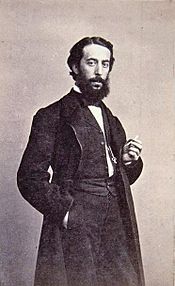Dióscoro Puebla facts for kids
Quick facts for kids
Dióscoro Puebla
|
|
|---|---|

Photograph by Jean Laurent, c.1860
|
|
| Born | 25 February 1831 Melgar de Fernamental, Spain
|
| Died | 24 October 1901 Madrid, Spain
|
| Education | Real Academia de Bellas Artes de San Fernando, Madrid |
Dióscoro Teófilo Puebla Tolín (born February 25, 1831 – died October 24, 1901) was a Spanish painter. He painted in a style called Eclectic Academic art. He was known for his portraits, everyday scenes, and paintings about history.
Contents
Dióscoro Puebla's Early Life
Dióscoro Puebla was born in a town called Melgar de Fernamental, Spain. He first went to school in Carrión de los Condes. There, he showed a great talent for drawing. This talent led him to study at a new art school in Palencia. This school, started in 1838, helped many famous Spanish artists get their start.
In 1845, Dióscoro went to the Real Academia de Bellas Artes de San Fernando in Madrid. This was a very important art academy. He learned from famous teachers like José de Madrazo and Carlos Luis de Ribera y Fieve.
Studying Art in Rome
After finishing his studies in Madrid, Dióscoro had a chance to improve his art even more. He won a special grant from the government. This grant gave him money to travel to Rome, Italy, for three years starting in 1858. In Rome, he joined a group of Spanish painters who often met at a famous coffee house called the Antico Caffè Greco. His grant was later extended for two more years. This allowed him to visit other parts of Italy and learn even more.
Dióscoro Puebla's Teaching Career
When Dióscoro Puebla returned to Spain in 1863, he became a professor. He taught about color and composition at the Real Academia Provincial de Bellas Artes de Cádiz. He did not stay there long. In 1865, he received a special appointment from the King. He became a professor at the Academy of San Fernando in Madrid, where he had once been a student.
Awards and Recognition
For the next 25 years, Dióscoro Puebla was very active in the art world. He often served on special groups that chose new teachers for the Spanish Academy of Fine Arts in Rome. In 1869, he received two important awards: the Order of Isabella the Catholic and the Order of Charles III. These awards showed how much his country valued his work.
He also showed his paintings in many big exhibitions. These included the Weltausstellung 1873 Wien (a world's fair in Vienna) and the Centennial Exposition in Philadelphia, USA.
In 1882, his fellow artists at San Fernando chose him to be an "Academician." This meant he was a top member of the academy. In 1897, he became the Director of the "School of Drawing, Painting and Engraving." He took over this role from Luis de Madrazo. Dióscoro Puebla passed away in Madrid when he was 70 years old.
Dióscoro Puebla's Famous Paintings
Even though he did not paint many historical scenes, these are his most famous works. Many of his portraits are displayed in the Congress of Deputies in Spain. This is like the country's parliament building. Some of these portraits include Nicomedes Pastor Díaz and Pedro José Pidal.
Images for kids
See also
 In Spanish: Dióscoro Puebla para niños
In Spanish: Dióscoro Puebla para niños


